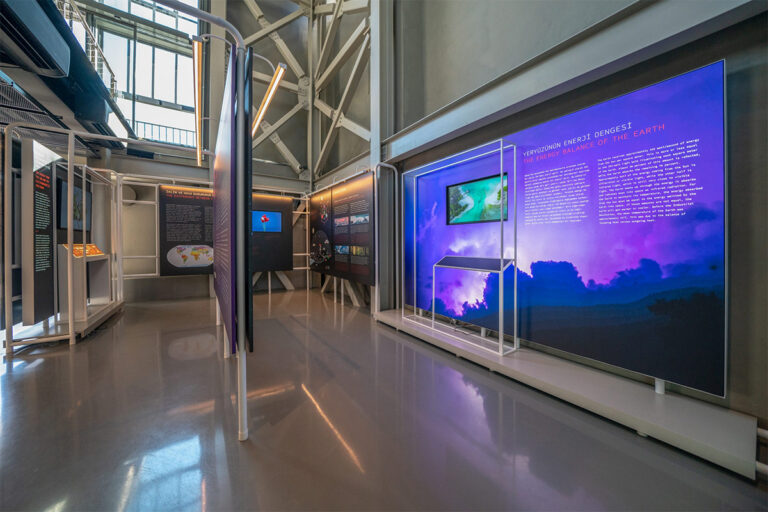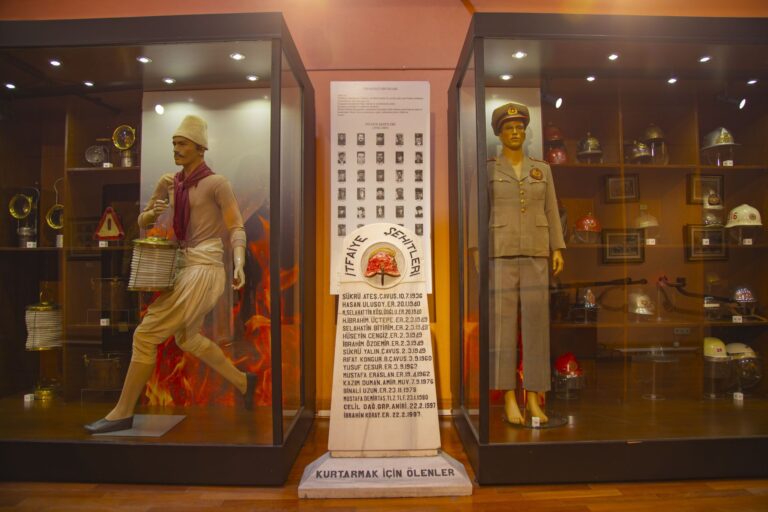Museum of the Princes’ Islands (Adalar Museum)
Discover the Adalar Museum: Istanbul’s First Contemporary City Museum
The Adalar Museum, Istanbul’s first contemporary city museum, presents the story of the Islands from their formation to the present day, through a rich collection comprising hundreds of objects, 20,000 documents, 6,000 photographs, numerous documentation shoots, films, and oral history recordings.
Located on Büyükada, the largest of the Prince’s Islands and part of Istanbul’s Adalar district, the museum opened on September 10, 2010, with the support of the Istanbul 2010 European Capital of Culture Agency. It is recognized as Istanbul’s first contemporary city museum. The museum, established in collaboration with the Adalar Foundation and Adalar Municipality, is situated in the Aya Nikola region of Büyükada, the island’s oldest historical settlement area. Its main building, hosting permanent exhibitions, is a renovated old helicopter hangar. The museum showcases the geological formation of the Prince’s Islands and their journey through time, with thousands of Ottoman archive documents, photographs, hundreds of documentary films, video clips documenting today’s Islands, documents obtained from public institutions serving on the Islands, oral history records, and donations from islanders.
The Adalar Museum aims to promote the multicultural history and values of the Islands while preserving the enriched social life shaped by its historical, cultural, and natural heritage, and to increase interest in the Prince’s Islands.
About the Princes’ Islands The Islands are one of Istanbul’s urban centers. One of the first districts to receive municipal services, the Islands are home to a highly educated population. The Adalar Museum contributes to the development of urban consciousness and facilitates the integration of a cosmopolitan population formed by migrations. The Islands boast a culture rich and colorful, spanning thousands of years. The museum conducts studies to understand, learn, examine, publish, and preserve the heritage of this unique geography, which is a living space for diverse cultures.
Museum Buildings The museum on Büyükada, the largest in terms of population and area among the Islands, comprises two different exhibition spaces:
- Çınar Museum Area (open-air exhibitions)
- Aya Nikola Hangar Museum Area (Permanent Exhibitions)
What’s in the Adalar (Princes’ Islands) Museum?
The “Permanent Exhibitions” include:
- 10 Minutes in the Prince’s Islands The Prince’s Islands were more than the five large islands inhabited today. Comprising ten islands, they were known by different names throughout history, hosting monasteries, fishing villages, exiles, and even a small island known as Vordonos Rocks, which sank after a major earthquake. This section offers glimpses into the past of the ten Prince’s Islands through maps, photographs, and current urban data in a video animation presentation.
- Nature and Formation of the Islands Prepared based on scientific research by Naci Görür, Mehmet Sakınç, Cengiz Zapçı, and Cenk Yaltırak from Istanbul Technical University, this section first answers the question, “What were the Islands like before they were islands?” It features the Geological Formation Video of the Islands and a story starting at the Armored Fish center, using fossils extracted by ITU that narrate the different periods of the Islands’ nature. A Geological Map allows visitors to embark on a Geo-Tour of Büyükada, providing information about the sea, living organisms, and rock structures according to the climatic characteristics of the periods to which the fossils belong. Visitors can explore five different points on a touch screen. The section continues with descriptions of past marine species found on the Islands, starting with prehistoric fish and ending with species that have disappeared today. A different presentation technique for fish and algae is displayed, along with a fun Microscope environment for children. Finally, visitors experience the invasion of slimy Mucilage in the sea, one of the most visible signs of marine pollution, accompanied by a gloomy voice-over. The research for this section on marine life on the Islands was conducted by faculty members Hüsamettin Balkıs and Neslihan Balkıs from Istanbul University’s Department of Hydrobiology, along with their students.
- First Human Traces on the Islands Prehistoric Istanbul was a passageway for the first humans who traveled west from the Marmara region about 1.2 million years ago. Scientists advocating that the first traces of humans in the Islands should have coincided with the first inhabitants of Istanbul discuss the yet-to-be-discovered history beneath the Islands’ soil in a prepared video clip.
- The First Inhabitants of the Islands This section, prepared following scientific research by Erendiz Özbayoğlu and Asnu Bilban Yalçın from Istanbul University, brings us closer to knowing the Islanders. We present the results of a surface survey in the Islands, from a Roman statue on the shore to the remnants visible in the Burgazada Hristos Monastery. Vivid engravings and detailed scenes depict the fate of the Islands during the Greek, Roman, and Byzantine eras, including life, exile, and a few fishermen. Examples from palace and monastery ruins on the Islands are also showcased.
- Island Architecture / Architects, Gardens Scientific background is provided by Elvan Altan Ergut from METU, Alev Erkmen and Hasan Kuruyazıcı from YTU, and Garden Historian Gürsan Ergil in the field of Island Architecture. The section covers the most important examples of diverse and aesthetic architectural features on the Islands, including architects and builders, with architectural characteristics. Approximately 400 significant buildings photographed on the Islands and aerial views from helicopter footage await visitors. Under the heading of Island Architecture, a study prepared as an example for 10 gardens offers the opportunity to take a tour under the title “Island Taste Tours / Garden Architecture.”
- Education on the Islands The section on Education on the Islands, featuring selections from Ottoman archive documents and objects and photographs from schools, awaits your visit. Work was done with Didem Özdarcan and İrfan Dağdelen.
- Traditions, Ceremonies, Flavors Research prepared by food expert Aylin Öney Tan on the Islands and Flavors, with support from Sula Bozis and Ahmet Tanrıverdi, is presented. While many Istanbulites have experienced the Islands as summer retreats, many families live there year-round. This study includes research and stories about the multiculturalism reflected in the kitchens of the Islands, differences between summer and winter lifestyles, seasonal migration stories, such as when refrigerators and stoves used to be moved from winter to summer residences.
- Literature Work was done with Sevengül Sönmez from Bilgi University on Island Writers and the Islands in Literature. This section, which narrates all local and foreign writers who have lived, passed through, and mentioned the Islands in their works, will particularly interest visitors with personal belongings, letters, and hats of Island writers enriching the presentation.
- Migration and Population Scientific research was conducted with Murat Güvenç and Eda Yücesoy from Bilgi University, with support from İlay Örs, on Migration and Population. Work on maps was done with Serdar Özbay. The Prince’s Islands have historically been both receiving and sending places of migration due to their location. Especially past and current social changes, political and social fractures have accelerated and intensified these migrations. The section discusses the population structure of the Islands, changes it has undergone, and resulting consequences.
Other Sections of the Princes’ Islands Museum
- Library: Offers a comprehensive collection of resources on the history and culture of the Islands.
- Archive: Hosts a rich archive collection documenting the historical and cultural heritage of the Islands.
- Website: Contains information and the event calendar presented in digital format.
- Events Workshops Children’s Education Programs: Various educational programs and cultural events for different age groups.
- Island Taste Tours: Tours organized to explore the traditional flavors and culinary culture of the Islands.
- Museum Friends: A community supporting and participating in museum activities.
- Publications: Various publications about museum studies and research.
- Cafeteria: A space offering light meals and drinks to visitors.
- Museum Shop: A shop selling museum-related souvenirs and books.
Visit and Contact Information
- Princes’ Islands Büyükada Aya Nikola Hangar
- Visit Days and Hours:
- Summer: 10.30 – 18.00
- Winter: 10.00 – 17.00
- Note: Aya Nikola Hangar Museum Area is closed on Mondays.
- Visit Days and Hours:
- Admission Fees:
- Regular Fee: 80 TL
- Discounted: 40 TL
- Foreign Visitor: 160 TL
- Free: Children under 12, persons with disabilities and their accompanying person, Ministry of Culture employees, ICOM/ICOMOS members, Professional Museum Association members, Adalar Municipality employees, Tour Guides, Press Card holders, Disability Card holders. (Please show ID to avail discounts.)
- For School & Group Tour Reservations: [email protected] / (216) 382 64 30 / (507) 202 81 82
- Address: Adalar Museum Hangar Museum Area, Aya Nikola Location, Büyükada / Adalar – ISTANBUL
- Phone: (216) 382 64 30
How to Get to the Princes’ Islands Adalar Museum? From the Istanbul Kabataş, Bostancı, and Kadıköy piers, after arriving at Büyükada by ferry, one can reach the museum either by a 3 km walk starting from the Büyükada ferry pier, accompanied by the island’s unique architectural beauties and sea views, or in 10 minutes by bicycle or by “Adabüs” which accepts Istanbul Kart, getting off at the Adalar Museum stop.
Adalar Museum Office
- Address: Adalar Museum Hangar Museum Area, Aya Nikola Location, Büyükada / Adalar – ISTANBUL
- Phone/Fax: (216) 382 64 30 / (507) 202 81 82
Visitor Comments (What Did They Say?)
- “A museum that made me question life on the Islands and in general. One of the must-visit places on the island.”
- “We went to the museum for the New Year’s market. Also, we had a wonderful day with a surprise jazz concert. Thanks to everyone who organized it.”
- “A calm and modest place, I liked it very much. The coffee and attention were great.”
- “Small but nice for someone like me who loves history and life experiences. Student 30₺. A very pleasant and sweet place.”
- “If you find yourself in Istanbul, definitely visit the Islands!))) Beauty, silence, sea, air; this place enchanted me. There’s a café by the sea, no cars but small taxis, reminding me of Bangkok tuk-tuks)) You can only get there by ferry from Istanbul, with daily trips. We bought our tickets online in advance, very convenient.”
- “If I remember correctly, the entrance fee was 60 lira. I was happy to find a museum of sufficient size when I was expecting a small one. At the entrance, you watch a short documentary to learn about the island’s geographical formation, and then you have the opportunity to get to know the different cultures and people hosted by the island. A sweet museum where science, history, and general culture intertwine. It’s possible to buy souvenirs at the entrance.”
- “Quaint. An old-style museum full of panels and objects placed side by side for reading. Let’s say it’s not very useful. The audio and video subtitles you download with the QR code are only in Turkish. I don’t know if it’s worth visiting. The ticket price is 4 euros.”




